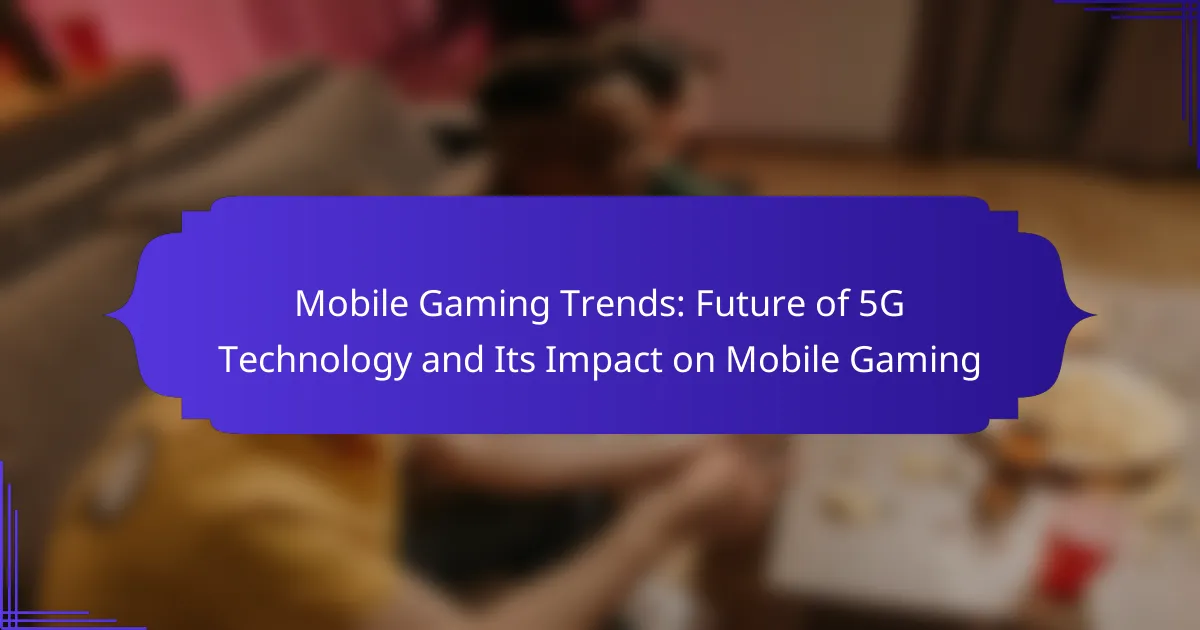5G technology is transforming mobile gaming by enhancing speed and reducing latency, leading to more immersive experiences. This article explores the impact of 5G on cloud gaming, cross-platform play, and the evolution of graphics. It also addresses challenges like network availability and device compatibility, while highlighting the future potential of mobile gaming revenue.
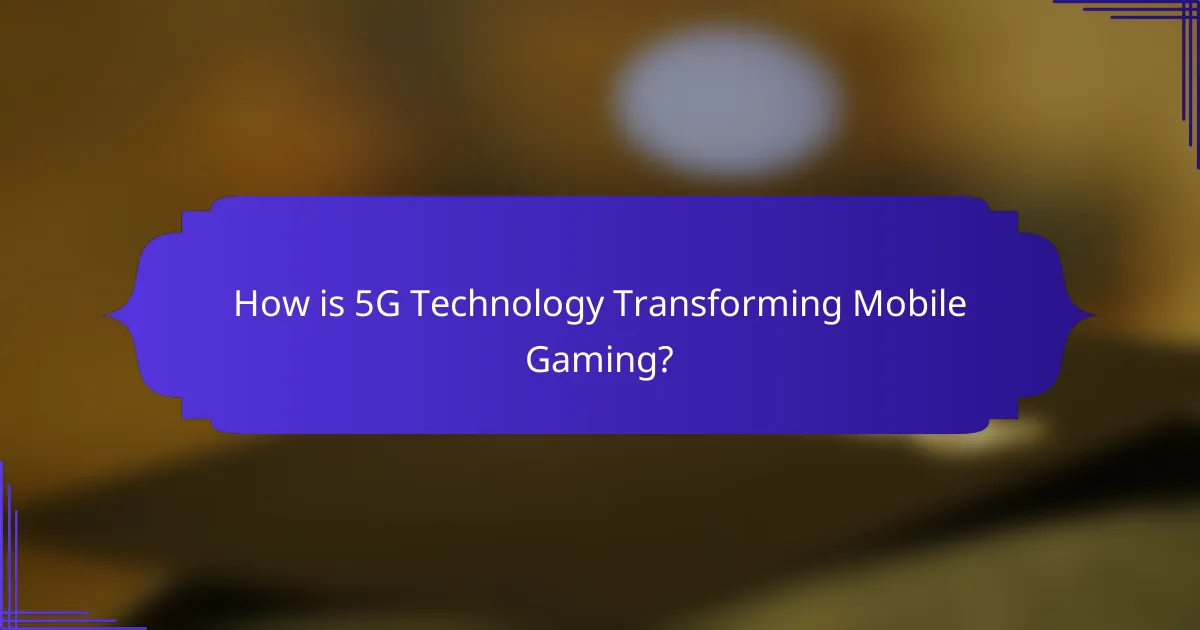
How is 5G Technology Transforming Mobile Gaming?
5G technology is revolutionising mobile gaming by enhancing speed, reducing latency, and enabling seamless multiplayer experiences. This transformation allows for high-quality graphics and immersive gameplay, attracting more users and developers.
The low latency of 5G, typically around 1 millisecond, facilitates real-time interactions, essential for competitive gaming. Enhanced speeds of up to 10 Gbps enable quick downloads and updates, improving user experience.
Moreover, 5G supports cloud gaming, allowing players to access high-performance games without needing powerful hardware. This accessibility expands the gaming audience significantly.
As a result, mobile gaming is becoming more engaging and dynamic, setting a new standard for future developments in the industry.
What are the Key Features of 5G That Enhance Mobile Gaming?
5G technology significantly enhances mobile gaming through lower latency, higher speeds, and improved connectivity. These features enable seamless gameplay, real-time interactions, and support for advanced graphics.
1. **Lower Latency**: 5G reduces latency to as low as 1 millisecond, allowing instant response times crucial for competitive gaming.
2. **Higher Speeds**: With speeds up to 10 Gbps, players experience faster downloads, quicker loading times, and smoother streaming.
3. **Enhanced Connectivity**: 5G supports more devices simultaneously, ensuring stable connections even in crowded areas.
4. **Improved Cloud Gaming**: Faster speeds and lower latency enhance cloud gaming experiences, enabling high-quality graphics without heavy device requirements.
5. **Augmented Reality (AR) and Virtual Reality (VR)**: 5G facilitates immersive AR and VR gaming experiences with rich content delivery and real-time interactions.
6. **Network Slicing**: This feature allows dedicated bandwidth for gaming, ensuring consistent performance during peak usage times.
How Does 5G Reduce Latency in Mobile Gaming?
5G significantly reduces latency in mobile gaming by enabling faster data transmission and processing. This technology achieves latency as low as 1 millisecond, enhancing real-time interactions. The increased bandwidth allows for smoother gameplay and reduced lag, which is crucial for competitive gaming. As a result, players experience more responsive controls and improved overall performance.
Which Mobile Games Are Best Optimized for 5G Connectivity?
Mobile games best optimized for 5G connectivity include titles that leverage high-speed data for enhanced performance. Games such as Call of Duty: Mobile, Fortnite, and PUBG Mobile provide seamless gameplay with reduced latency. These titles utilize 5G’s capabilities to support real-time multiplayer experiences and high-quality graphics. Additionally, racing games like Asphalt 9: Legends benefit from faster downloads and smoother streaming, making them ideal for 5G networks. Overall, 5G technology significantly enhances mobile gaming experiences by enabling richer graphics and more interactive gameplay.
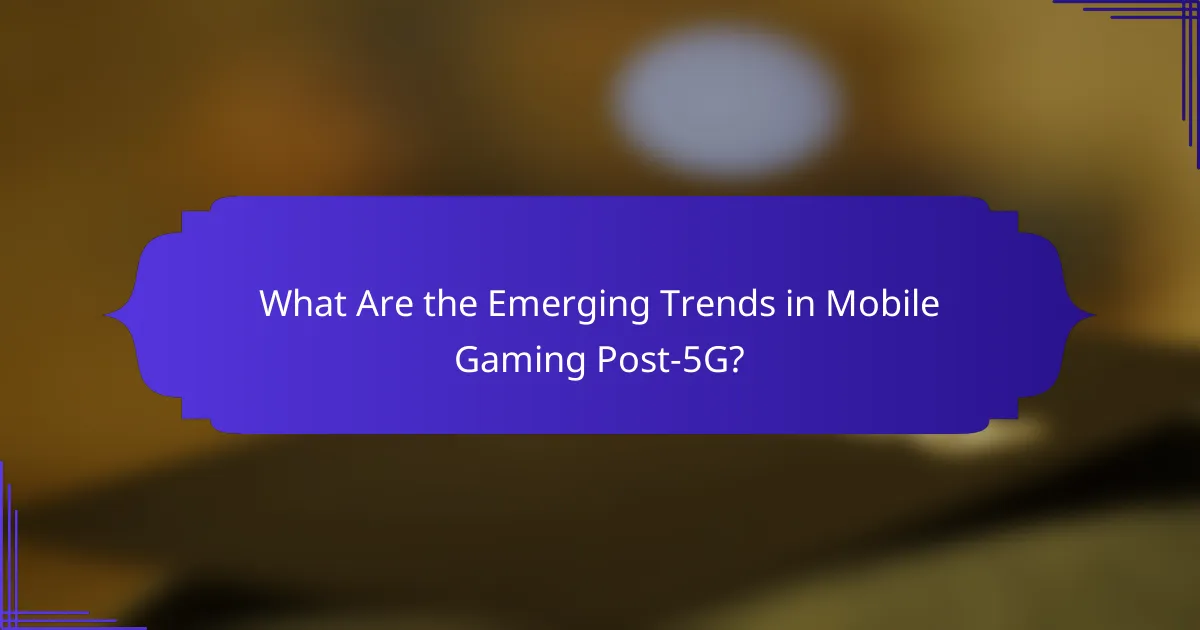
What Are the Emerging Trends in Mobile Gaming Post-5G?
5G technology is revolutionising mobile gaming by enabling faster speeds, lower latency, and enhanced connectivity. This allows for more immersive experiences, including augmented reality and cloud gaming.
One emerging trend is the rise of cross-platform play, which 5G supports by allowing seamless interaction between different devices. Another trend is the increased use of real-time multiplayer features, enhancing player engagement and competition.
Additionally, 5G facilitates the development of high-fidelity graphics and complex game environments, pushing the boundaries of mobile gaming aesthetics. As a result, developers are creating more sophisticated games that leverage these technological advancements.
The accessibility of mobile gaming is also improving, as 5G networks expand globally, reaching underserved areas. This democratization of gaming opens new markets and opportunities for both players and developers.
How Are Developers Adapting to 5G Capabilities?
Developers are leveraging 5G capabilities to enhance mobile gaming experiences. The increased bandwidth and reduced latency enable real-time multiplayer interactions and immersive graphics. Developers are focusing on cloud gaming, allowing players to access high-quality games without extensive downloads. Furthermore, 5G facilitates augmented reality (AR) and virtual reality (VR) integration, creating engaging and interactive gameplay. As a result, mobile gaming is evolving rapidly, with developers prioritising innovative features that fully utilise 5G technology.
What Role Does Cloud Gaming Play in the 5G Era?
Cloud gaming significantly enhances mobile gaming in the 5G era by providing low latency and high-speed connectivity. This technology allows seamless streaming of high-quality games directly to mobile devices, eliminating the need for powerful hardware. As a result, gamers can enjoy immersive experiences and access a broader range of titles without downloading large files. The unique attribute of 5G technology, with speeds up to 10 Gbps, enables real-time interactions and multiplayer gaming, transforming how players engage with games.
Which Genres of Mobile Games Benefit Most from 5G?
Action-adventure, multiplayer online battle arena (MOBA), and augmented reality games benefit most from 5G technology. These genres leverage low latency and high-speed connectivity for enhanced user experiences. For example, action-adventure games can deliver seamless graphics and real-time interactions. MOBA games thrive on fast response times, crucial for competitive play. Augmented reality games utilise 5G to provide immersive experiences with real-world integration. Overall, 5G significantly enhances gameplay across these genres, enabling richer, more engaging mobile gaming experiences.
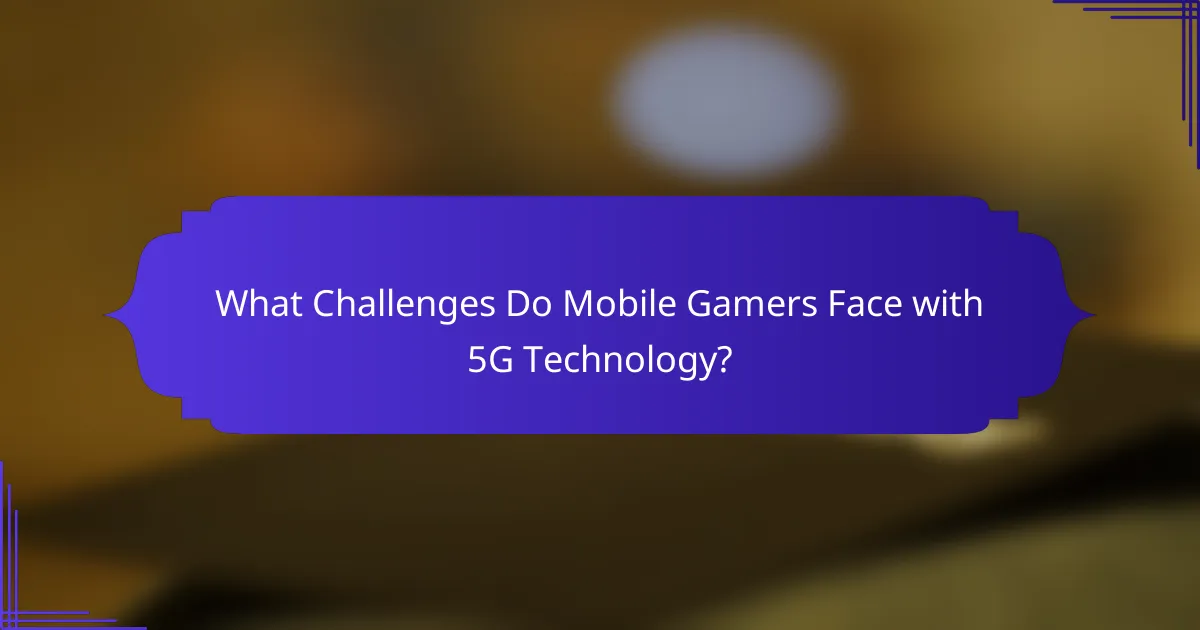
What Challenges Do Mobile Gamers Face with 5G Technology?
Mobile gamers face several challenges with 5G technology, including network availability, latency issues, and device compatibility. Limited 5G coverage can hinder access in rural areas. High-speed connections may still experience latency due to network congestion. Additionally, not all mobile devices support 5G, which can restrict the gaming experience. Security concerns also arise with increased connectivity, making users wary of data privacy. Finally, the cost of upgrading to 5G-capable devices can be a barrier for many gamers.
How Does Network Coverage Affect Mobile Gaming Experience?
Network coverage significantly enhances the mobile gaming experience by reducing latency and improving connection stability. Stronger signals enable smoother gameplay, minimising lag and interruptions. As 5G technology expands, it promises faster download speeds, allowing for high-quality graphics and real-time multiplayer interactions. This advancement will likely lead to more immersive gaming experiences, making network coverage a crucial factor in the future of mobile gaming.
What Are the Security Concerns with 5G in Mobile Gaming?
5G technology in mobile gaming raises significant security concerns, including data privacy, network vulnerabilities, and potential for cyberattacks. The increased connectivity speeds and device interactivity can expose users to threats if security measures are inadequate. As mobile gaming evolves, developers must prioritise robust encryption and secure authentication to protect user data and maintain trust.
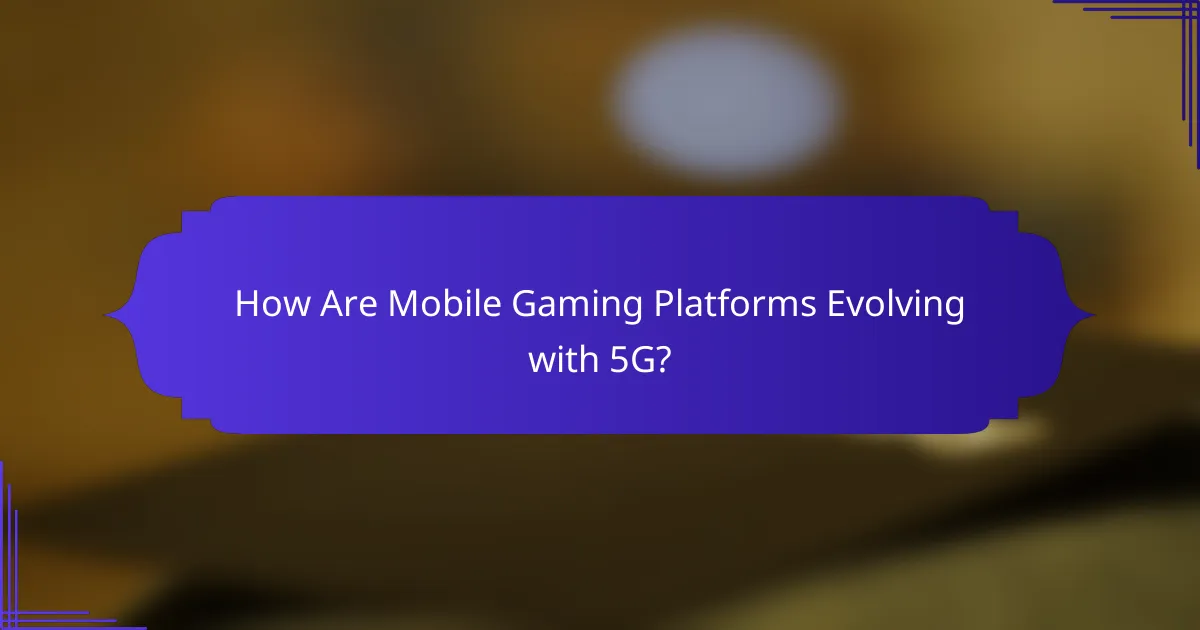
How Are Mobile Gaming Platforms Evolving with 5G?
Mobile gaming platforms are rapidly evolving with 5G technology, enhancing user experiences significantly. The increased data speeds and reduced latency of 5G allow for seamless multiplayer interactions and higher-quality graphics. This evolution supports immersive experiences through augmented reality and virtual reality applications, which were previously limited by slower network speeds. Additionally, cloud gaming services are gaining traction, enabling players to access high-performance games without requiring advanced hardware. As a result, mobile gaming is becoming more accessible and engaging, catering to a broader audience.
Which Platforms Are Leading the Charge in 5G Gaming?
Leading platforms in 5G gaming include NVIDIA GeForce NOW, Microsoft xCloud, and PlayStation Remote Play. These services leverage 5G technology to enhance mobile gaming experiences with reduced latency and improved graphics. As a result, players enjoy seamless gameplay on mobile devices. Emerging devices like the ASUS ROG Phone 5 and Samsung Galaxy S21 support these platforms, optimising performance and connectivity.
What Innovations Are Being Introduced by Major Gaming Brands?
Major gaming brands are introducing innovations that leverage 5G technology to enhance mobile gaming experiences. These innovations include lower latency, which allows for real-time multiplayer interactions, and improved graphics quality due to faster data transmission. As a result, players can enjoy seamless gameplay and immersive environments. Additionally, cloud gaming services are becoming more prevalent, enabling gamers to access high-quality titles without the need for powerful hardware. This shift is expected to democratise gaming access and expand the player base significantly.
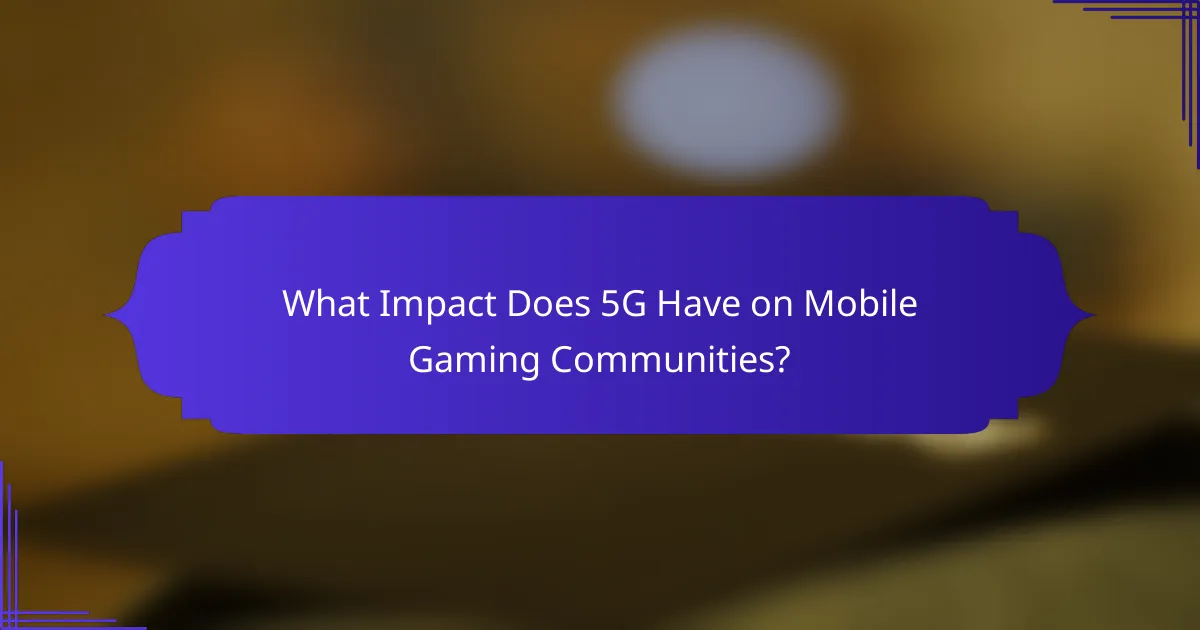
What Impact Does 5G Have on Mobile Gaming Communities?
5G technology significantly enhances mobile gaming communities by providing faster speeds, lower latency, and improved connectivity. These advancements foster real-time interactions and immersive experiences, transforming multiplayer gaming dynamics.
The introduction of 5G facilitates seamless streaming of high-definition graphics, enabling developers to create more complex and engaging game environments. As a result, players enjoy smoother gameplay and reduced lag, which are critical for competitive gaming.
Moreover, 5G supports augmented reality and virtual reality applications in mobile gaming. This unique attribute allows for innovative gameplay experiences that were previously unattainable on mobile devices.
Finally, increased bandwidth from 5G enables larger player bases and more simultaneous connections, enhancing community engagement. This rare attribute encourages social interactions, cooperative gameplay, and shared experiences among gamers.
How Are Social Features Enhanced in Mobile Gaming with 5G?
5G technology significantly enhances social features in mobile gaming by enabling real-time interactions. This improvement allows for seamless multiplayer experiences, reducing latency to nearly zero. Players can communicate instantly, share content, and join games without lag. Enhanced connectivity fosters a more immersive and engaging social environment, encouraging collaboration and competition. As a result, gamers can enjoy a richer community experience, building stronger connections through shared gameplay.
What New Opportunities for Collaboration Are Emerging?
Emerging opportunities for collaboration in mobile gaming include cross-platform play, cloud gaming integration, and partnerships with telecommunications for enhanced 5G experiences. These developments enable seamless interactions among players, fostering a more interconnected gaming community. As 5G technology advances, it supports real-time multiplayer experiences, allowing developers to create innovative gameplay mechanics and immersive environments. Additionally, collaborations between game developers and hardware manufacturers can lead to optimised performance and new gaming experiences tailored for mobile devices.
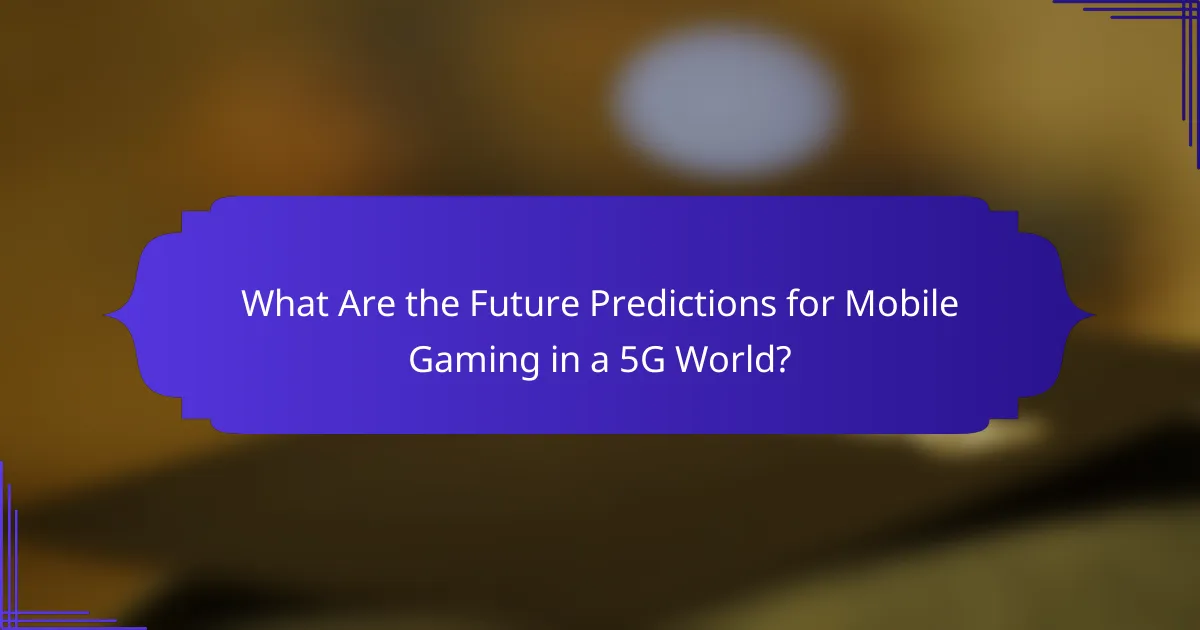
What Are the Future Predictions for Mobile Gaming in a 5G World?
Mobile gaming is set to thrive in a 5G world, enhancing user experiences and gameplay. The increased bandwidth and reduced latency will enable richer graphics, seamless multiplayer experiences, and augmented reality features. As a result, developers will create more immersive games that leverage these capabilities. Predictions indicate that mobile gaming revenue could exceed $100 billion by 2025, driven by 5G adoption. Furthermore, 5G will facilitate cloud gaming, allowing players to access high-quality games without powerful devices. This evolution will attract a broader audience and redefine gaming engagement.
How Will User Engagement Change with 5G Gaming?
User engagement will significantly increase with 5G gaming due to enhanced speed and connectivity. The low latency of 5G networks allows for real-time interactions, making multiplayer experiences smoother. As a result, players will enjoy more immersive gameplay, leading to longer session durations and increased social interactions. Moreover, 5G technology enables high-quality graphics and richer content, further elevating user experiences and engagement levels.
What Are the Potential Market Growth Opportunities in 5G Mobile Gaming?
5G mobile gaming presents substantial market growth opportunities through enhanced connectivity, reduced latency, and immersive experiences. The global mobile gaming market is projected to reach $272 billion by 2030, driven by 5G technology.
Key opportunities include:
– **Cloud Gaming**: 5G enables high-quality cloud gaming, allowing players to stream games without high-end devices.
– **Augmented Reality (AR) Experiences**: Enhanced bandwidth supports AR games, creating interactive environments.
– **Increased Engagement**: Faster speeds encourage social gaming and multiplayer experiences, increasing player retention.
– **New Revenue Streams**: In-game purchases and subscriptions can flourish with improved user experiences.
As a result, the integration of 5G technology will revolutionise mobile gaming, creating a dynamic landscape for developers and players alike.
What Best Practices Should Developers Follow for 5G Mobile Games?
Developers should prioritise optimisation, user experience, and innovative gameplay in 5G mobile games. High-speed connectivity enables real-time interactions and immersive graphics. They must also integrate cloud gaming solutions to enhance performance and reduce latency. Collaborating with telecom providers ensures seamless integration of 5G features. Additionally, developers should adopt adaptive streaming techniques to maintain quality across varying network conditions.
